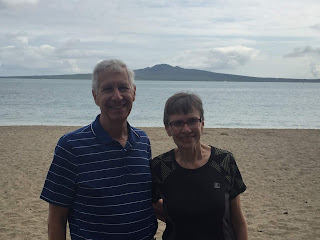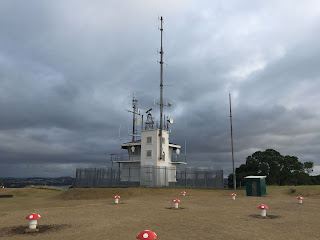Of all the major cities in the world, Auckland is one of them. It’s not a particularly bad city. It’s not a particularly nice city. It’s just another city. On our day tour today we saw a few things that are unique, and we saw a lot of things that are much like modern cities everywhere.
Our tour began at the Michael Joseph Savage Memorial. Savage was the first Labour Party prime minister of New Zealand from 1935 until his death in 1940. He was New Zealand’s FDR, taking over in the midst of the Great Depression and initiating economic reforms. He is considered to be the architect of New Zealand’s social welfare system.
Savage’s memorial is in a park overlooking the city. The view is nice and the gardens are well-maintained.
Nearby is the meeting house of the local Maori Iwi (EE-wee) or tribe. Since the reparations, the Iwi is a major landholder in downtown Auckland, and collects sizeable rents.
This meeting house is used for formal ceremonies. President Obama was welcomed here when he visited New Zealand. His traditional Maori welcome ceremony was a bit more ornate than the one we experienced in Wellington a couple weeks ago.
We drove on to a beach at Mission Bay, where we got a nice view of Rangitoto, Aukland’s youngest dormant volcano. In an eruption approximately 600 years ago, Rangitoto created its own island, which is now a nature preserve.
Mission Bay is also where the first Anglican missionaries originally set up shop to convert the Maori to Christianity. They were rather successful in doing that, but all that remains of the mission today is an old stone church, which is now a restaurant.
On the drive from the beach, our tour director had the bus driver take some back streets through one of the most expensive neighborhoods in all of New Zealand. Homes here have wonderful views, but run to many millions of dollars.
The wealthy residents tried to get tourist coaches banned from their street some time ago. The measure didn’t pass, and the street remains public. But in sort of a passive-aggressive move, many tour guides insist on using this public street, even when it’s out of the way. Many of the homes were beautiful, but as our tour leader remarked, “Money doesn’t necessarily buy good taste.”
We drove past the Auckland Museum, which is a free time option for us. But it didn’t sound terribly intriguing. We continued through the “Aukland Domain” (short for public domain — a very large park) to “The Winter Garden.”
The name is ironic, because this far north, Aukland is in a sub-tropical zone and gets very little in the way of winter weather. Nevertheless, this collection of three green houses, or conservatories, is full of beautiful flowering plants, ferns, a some interesting birds.
Next stop, Maungawhau, also known as Mt. Eden, a dormant volcanic cone quite near downtown. The bus took us about 2/3rds the way up, then it was a steep walk. But the panoramic view of the city, and of the caldera at the top, was quite stunning.
We could really get a feel for how spread out the city is. Aucklanders tend to avoid high rise housing, and prefer single family homes. The homes are usually only one story, two at most. It probably has to do with earthquakes.
Finally, we ended back at the waterfront. We walked through the marina, past rows of very large, very expensive motor yaughts. In the area of the fish market, our tour ended. We explored here a bit — the fish market is more a collection of pricey seafood restaurants than an actual fish market. Then we tried to visit the America’s Cup Sailing Center (New Zealand will host the race in 2021), but it is still under construction except for the shop.
Feeling tired and a bit warm in the midday sun, we caught the City Link, a city bus that drives a continuous loop through the CBD for only one New Zealand dollar a ride (about 66 cents U.S.). It was easy, and dropped us only a few blocks from our hotel.
We visited a few shops on Queen Street, then began the trek up hill toward the hotel. But we had to pass The Shakespeare, an old, red brick hotel that bills itself as “The oldest microbrew pub in New Zealand.” We felt obligated to stop in for historical reasons, and to sit awhile and enjoy a brew.
A short detour took us to the base of Aukland’s iconic Sky Tower, and past the headquarters of TVNZ, New Zealand’s equivalent of the BBC, the state-owned TV network. We stopped in, but no tours are given. So, we returned to the hotel, showered and got ready for the evening farewell dinner.
We met in the lobby and walked together back down to the waterfront, where we all boarded a ferry for Devonport, a peninsula across the bay. The ferry was packed with people headed home to the northern suburbs from work in the city.
Our excellent dinner was at The Esplanade restaurant, located in a splendid, 120 year old hotel right on the waterfront. Following the meal, many returned on the next ferry, but some of us remained. Four of us climbed Mt. Victoria (Takarunga), yet another volcanic cone.
This one has no caldera at the top, but a good deal of history. The New Zealand Navy put a large gun emplacement here to guard the harbor a century ago. Bunkers were built here during WW II.
And the Navy still maintains a radar and weather station here. Views of the harbor and the city were even better here than on Maungawhau earlier in the day.
After our return ferry ride, we walked back the hotel. Our tour is now officially over, but we still have some time to kill before we fly home tomorrow night.
Our tour began at the Michael Joseph Savage Memorial. Savage was the first Labour Party prime minister of New Zealand from 1935 until his death in 1940. He was New Zealand’s FDR, taking over in the midst of the Great Depression and initiating economic reforms. He is considered to be the architect of New Zealand’s social welfare system.
Savage’s memorial is in a park overlooking the city. The view is nice and the gardens are well-maintained.
This meeting house is used for formal ceremonies. President Obama was welcomed here when he visited New Zealand. His traditional Maori welcome ceremony was a bit more ornate than the one we experienced in Wellington a couple weeks ago.
We drove on to a beach at Mission Bay, where we got a nice view of Rangitoto, Aukland’s youngest dormant volcano. In an eruption approximately 600 years ago, Rangitoto created its own island, which is now a nature preserve.
Mission Bay is also where the first Anglican missionaries originally set up shop to convert the Maori to Christianity. They were rather successful in doing that, but all that remains of the mission today is an old stone church, which is now a restaurant.
On the drive from the beach, our tour director had the bus driver take some back streets through one of the most expensive neighborhoods in all of New Zealand. Homes here have wonderful views, but run to many millions of dollars.
The wealthy residents tried to get tourist coaches banned from their street some time ago. The measure didn’t pass, and the street remains public. But in sort of a passive-aggressive move, many tour guides insist on using this public street, even when it’s out of the way. Many of the homes were beautiful, but as our tour leader remarked, “Money doesn’t necessarily buy good taste.”
We drove past the Auckland Museum, which is a free time option for us. But it didn’t sound terribly intriguing. We continued through the “Aukland Domain” (short for public domain — a very large park) to “The Winter Garden.”
Next stop, Maungawhau, also known as Mt. Eden, a dormant volcanic cone quite near downtown. The bus took us about 2/3rds the way up, then it was a steep walk. But the panoramic view of the city, and of the caldera at the top, was quite stunning.
We could really get a feel for how spread out the city is. Aucklanders tend to avoid high rise housing, and prefer single family homes. The homes are usually only one story, two at most. It probably has to do with earthquakes.
Finally, we ended back at the waterfront. We walked through the marina, past rows of very large, very expensive motor yaughts. In the area of the fish market, our tour ended. We explored here a bit — the fish market is more a collection of pricey seafood restaurants than an actual fish market. Then we tried to visit the America’s Cup Sailing Center (New Zealand will host the race in 2021), but it is still under construction except for the shop.
Feeling tired and a bit warm in the midday sun, we caught the City Link, a city bus that drives a continuous loop through the CBD for only one New Zealand dollar a ride (about 66 cents U.S.). It was easy, and dropped us only a few blocks from our hotel.
We visited a few shops on Queen Street, then began the trek up hill toward the hotel. But we had to pass The Shakespeare, an old, red brick hotel that bills itself as “The oldest microbrew pub in New Zealand.” We felt obligated to stop in for historical reasons, and to sit awhile and enjoy a brew.
A short detour took us to the base of Aukland’s iconic Sky Tower, and past the headquarters of TVNZ, New Zealand’s equivalent of the BBC, the state-owned TV network. We stopped in, but no tours are given. So, we returned to the hotel, showered and got ready for the evening farewell dinner.
We met in the lobby and walked together back down to the waterfront, where we all boarded a ferry for Devonport, a peninsula across the bay. The ferry was packed with people headed home to the northern suburbs from work in the city.
Our excellent dinner was at The Esplanade restaurant, located in a splendid, 120 year old hotel right on the waterfront. Following the meal, many returned on the next ferry, but some of us remained. Four of us climbed Mt. Victoria (Takarunga), yet another volcanic cone.
This one has no caldera at the top, but a good deal of history. The New Zealand Navy put a large gun emplacement here to guard the harbor a century ago. Bunkers were built here during WW II.
And the Navy still maintains a radar and weather station here. Views of the harbor and the city were even better here than on Maungawhau earlier in the day.
After our return ferry ride, we walked back the hotel. Our tour is now officially over, but we still have some time to kill before we fly home tomorrow night.
















No comments:
Post a Comment